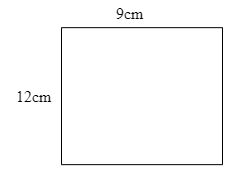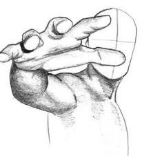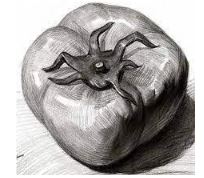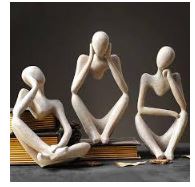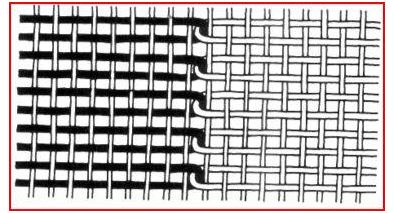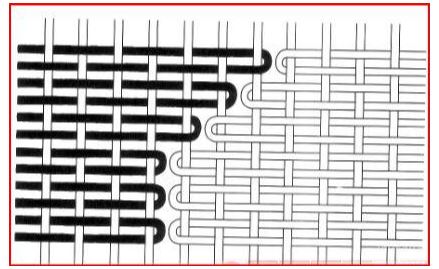INSTRUCTIONS TO CANDIDATES
- This question paper consists of three sections A, B and C.
- Answer all questions in section A and B.
- Answer any one question in section C
SECTION A (20 marks)
Answer all questions in this section.
-
- What is a view finder. (1 mark)
- State two basic ways of spacing typography. (2 mark)
- Describe the method of printing that is used to create halftones (2 marks)
- State the difference between readability and legibility in a design (2 marks)
- Collage technique can also be executed using one material. State two characteristics that will make the composition differ from mosaic. (2 marks)
- Describe how to achieve the crackle effect
- in batik (1 mark)
- in mosaic (1 mark)
- The illustration below represents a mounting board measuring 12cm by 9cm.
- illustrate how you would mount a picture on it measuring 7cm by 5cm. (2 marks)
- illustrate how you would mount a picture on it measuring 7cm by 5cm. (2 marks)
- The function of an ornament often determines it’s style. Discuss (1 mark)
- State two functions of a loom in weaving. (2 marks)
- Name and describe any two directions in which motifs can be placed in printmaking. (2 marks)
- Describe the drawing technique illustrated in the image below (1 mark)
- Decribe two ways of creating atmospheric perspective in painting a landscape. (2 marks)
SECTION B (25 MARKS)
Answer all questions in this section.
- Clearly illustrate the following tapesty weaves and label appropriately.
- Interlocking tapestry (1 ½ marks)
- Tapestry Angle (1 ½ marks)
- Describe two ways of correcting the waisting defect while weaving (2 marks)
-
- Describe the procedure for making a free standing sculpture using the construction technique. (3 marks)
- Describe any two types of relief in sculpture (2 marks)
- Discuss these ceramic decoration techniques (5 marks)
Incising
Burnishing
SlipTrailing
Sgraffito
Excising -
- Study the figure below.
Name the technique used to draw texture in the illustration (2 marks) - Explain three uses of line in the model the form above (3 marks)
- Study the figure below.
-
- Identify two uses of voids in the sculpture below (2 marks)
- Describe two key areas that influences the choice or selection of the subject matter in sculpture. (2 marks)
- What is an armature in sculpture. (1 mark)
- Identify two uses of voids in the sculpture below (2 marks)
SECTION C (15 MARKS)
Attempt only ONE question.
-
- Describe the following technique used in painting
- brush stroke technique (2 marks)
- flat wash technique (2 marks)
-
- Apart from linear perspective mention any other perspective used on landscapes. (1 mark)
- Give three characteristics of linear perspective. (4 marks)
- Using a well labelled diagram, illustrate two point perspective. (7 marks)
- Describe the following technique used in painting
-
- Describe one function of a pyrometric cone. (1mark)
- Describe any two changes that takes place during the following
- Bisque fire (2 marks)
- Glaze fire (2 marks)
- Explain three uses of a thin wire used in ceramics. (3 marks)
- Describe the coiling technique in ceramics. (7 marks)
- Describe the process of creating a three color batik fabric (15 marks)
MARKING SCHEME
SECTION A (20 marks)
Answer all questions in this section.
-
- What is a view finder. (1 mark)
- A viewfinder is a simple square or rectangle cut out of card that you can look through. Using a viewfinder helps you to focus on something and not get distracted by what's around it. It will help you pay close attention to the image that you are trying to create.
- State two basic ways of spacing typography. (2 mark)
- Kerns spacing between letters
- Trackes spacing between words
- Leading spacing between sentences
- Describe the method of printing that is used to create halftones (2 marks)
- Aquatint- An infinite number of tones can be achieved by exposing various parts of the plate to acid baths of different strengths for different periods of time. Tones can also be altered by scraping and burnishing. Etched or engraved lines are often used with aquatint to achieve greater definition of form.
- State the difference between readability and legibility in a design (2 marks)
- Legibility is an informal measure of how easy it is to distinguish one letter from another in a particular typeface or fonts. Readability is about the reader – the ease with which a reader can successfully decipher, process, and make meaning of the text read.
- Collage technique can also be executed using one material. State two characteristics that will make the composition differ from mosaic. (2 marks)
-
- Overlapping of the materials in mosaic , the mateials are placed next to each other.
- Combination with drawing and painting on the composition which does not happen in mosaic
- Describe how to achieve the crackle effect
- in batik (1 mark)
- wax cracking and dye penetrating through
- in mosaic (1 mark)
- Use of interstices, the spaces in between the tesserae
- in batik (1 mark)
- The illustration below represents a mounting board measuring 12cm by 9cm.
- illustrate how you would mount a picture on it measuring 7cm by 5cm. (2 marks)
Image should be centre and palced with even spacing at the top and two sides and double the space at the bottom
- illustrate how you would mount a picture on it measuring 7cm by 5cm. (2 marks)
- The function of an ornament often determines it’s style. Discuss (1 mark)
- The function will dictate the audience, type of material to be used hence the designer will design its style using those metrics
- State two functions of a loom in weaving. (2 marks)
- Hold and separate warp threads
- Determine length of weave
- Name and describe any two directions in which motifs can be placed in printmaking. (2 marks)
- Unidirectional where the motifs seem to be moving toward one direction
- Bi derectional where the motifs semm to be moving in two distict direction
- Multidirectionl whee the motifs seem to move in different direcions
- Describe the drawing technique illustrated in the image below (1 mark)
Foreshortening - Decribe two ways of creating atmospheric perspective in painting a landscape. (2 marks)
- Blurry hazy colors at the background white sharper colors and focus at the foreground
- Warmer colors in the foreground and cool at the background
- Objects in th background pick up color of sky
- What is a view finder. (1 mark)
SECTION B (25 MARKS)
Answer all questions in this section.
- Clearly illustrate the following tapesty weaves and label appropriately.
- Interlocking tapestry (1 ½ marks)
- Angle tapestry (1 ½ marks)
- Describe two ways of correcting the waisting defect while weaving (2 marks)
- Loosening the warp threads a bit
- Not pulling the weft thread heavily
- Ensuring correct tension of warp threads
- Interlocking tapestry (1 ½ marks)
-
- Describe the procedure for making a free standing sculpture using the construction technique.
- sketch
- Collect materials and tools
- Join them together with appropriate joining techniques
- make sure it is visible from all sides using the elements and principles of sculpture
- Finish (3 marks)
- Describe any two types of relief in sculpture (2 marks)
- Bas relief ..Releif that projects to almost half the base of sculpture
- Low relief- Very low projection off the base of sculpture
- High releif - Projection is high almost like a sculptue in the round
- Inverse relief -incisions are made on sculpture
- Describe the procedure for making a free standing sculpture using the construction technique.
- Discuss these ceramic decoration techniques (5 marks)
- Incising - to engrave a design by cutting or scraping into the clay surface at any stage of drying, from soft to bone dry.
- Burnishing - clay is polished to a beautiful sheen without the use of glaze by a smooth surface like spoon or pebble
- SlipTrailing - the application to a clay surface of lines of slip using a fine-pointed dispenser or a rubber sucker
- Sgraffito - a technique where potters can put a layer of glaze or slip on a piece of pottery, let it dry, then use a pottery carving tool to scratch at it to show the base layer of color.
- Excising - strips or shapes are cut out from the vessel walls before firing and while the pot is still soft.
-
- Study the figure below.
Name the technique used to draw texture in the illustration (2 marks)- Crosshatching and hatching
- Explain three uses of line in the model the form above (3 marks)
- Lines have been used to model the form
- Line shave been used to create illusion of depth
- Line has been used to show movement on the form
- Study the figure below.
-
- Identify two uses of voids in the sculpture below (2 marks)
- Voids have been used to create interesting contrast in the form
- Voids have been used to model the form
- Describe two key areas that influences the choice or selection of the subject matter in sculpture. (2 marks)
- The function of the sculpture will determine
- The placement of the sculpture
- What is an armature in sculpture. (1 mark)
- In sculpture, an armature is a framework or skeleton around which the sculpture is built, when the sculpture could not stand on its own.
- Identify two uses of voids in the sculpture below (2 marks)
SECTION C (15 MARKS)
Attempt only ONE question.
-
- Describe the following technique used in painting
- brush stroke technique (2 marks)
- the configuration given to paint by contact with the bristles of a brush. also : the paint left on a surface by a single application of a brush or palette knife. often used figuratively to describe the quality especially of a narrative or description.
- flat wash technique (2 marks)
- To apply a flat wash, you need to dilute some color in water, then apply it uniformly to part of the composition (to paint a sky, for example) or to the whole sheet of paper (to create the background).
- brush stroke technique (2 marks)
-
- A part from linear perspective mention any other perspective used on landscapes.
- Atmospheric/aerial perspective (1 mark)
- Give three characteristics of linear perspective. (3 marks)
- objects appear smaller as their distance from the observer increases, and that they are subject to foreshortening,
- there is the vanishing point ,the spot on the horizon line to which the receding parallel lines diminish.
- there is an horizon line which is a type of eye-level line. Eye-level lines refer to the natural point of perspective drawing
- Using a well labelled diagram, illustrate two point perspective. (7 marks)
- Student to label the vanishing points, orthogonal lines an horizon line in the drawing
- A part from linear perspective mention any other perspective used on landscapes.
- Describe the following technique used in painting
-
- Describe one function of a pyrometric cone. (1mark)
- Check temperatures in a kiln
- Describe any two changes that takes place during the following
- Bisque fire (2 marks)
- Clay changes to permanent state
- Clay changes color
- Glaze fire (2 marks)
- Both the clay and the glaze undergo changes.
- The clay matures and the glaze melts to the clay surface and forming a bond with the clay.
- Bisque fire (2 marks)
- Explain three uses of a thin wire used in ceramics. (3 marks)
- as a decorative accent on pottery.
- To decorate the ceramics
- as loops for kiln fired jewelry
- an armature wire to support beads or small objects during firing
- To remove articles from the potterws wheel
- To slice through wedged clay to check for airpockets
- Describe the coiling technique in ceramics. (7 marks)
- The process involves taking a small amount of clay, and then rolling it out on a flat surface until it forms a rope-like shape, called a coil.
- The coils are used as a way of building the ‘walls’ of the piece by being placed on top of each other, one layer at a time.
- The walls of coils are then gradually built up upon one another, one layer at a time. This can be a slower method than throwing clay on a potter’s wheel, but the technique of coiling allows the maker to build with thicker, strong and taller walls.
- The gradual process of building up the walls layer by layer gives more control to maker, whop can manipulate shape, direction and thickness of the walls. This would be much more difficult to do on the wheel.
- The coils can be left exposed on the outside, as a visual feature of the piece. They can also be smoothed out by hand and joined seamlessly.
- Describe one function of a pyrometric cone. (1mark)
- Describe the process of creating a three color batik fabric (15 marks)
- Step 1
- Sketch design and transfer it to fabric
- Melt wax over double containers
- Use either tjantin or tjaps to pick up wax
- The first wax is applied over the penciled-in outline of the pattern. Almost always the original cloth is white or beige.
- Step 2
- The cloth is dyed in the first dye bath. In this case the first dyebath is indigo blue. The area of the cloth where the wax was applied in Step 1 will remain white.
- Step 3
- Second application of wax is applied. In this case it is a dark brown color. A poorer quality of wax is used to cover larger areas of cloth. The darker color helps to differentiate it from the first wax applied. Any parts that are covered with this wax application will remain the indigo color.
- Step 4
- The cloth is dyed in the second dye bath. In this case it is a navy blue. Any areas that are not covered by wax will become dark blue.
- Step 5
- All the wax that has been applied thus far is removed. This is done by heating the wax and scraping it off and also by applying hot water and sponging off the remaining wax.
- Step 6
- Wax is applied to the area of the fabric that the artist wishes to remain the indigo blue color.
- Step 7
- The finished cloth after all of the wax has been removed by either ironing or running through hot water .
- Step 1
Download Art and Design Paper 1 Questions and Answers - Lainaku II Joint Mock Examination 2023.
Tap Here to Download for 50/-
Get on WhatsApp for 50/-
Why download?
- ✔ To read offline at any time.
- ✔ To Print at your convenience
- ✔ Share Easily with Friends / Students

